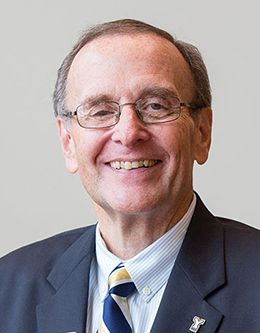The mission of BYU “is to assist individuals in their quest for perfection and eternal life.” This mission does not end today at graduation. Your learning doesn’t end, your quest doesn’t end, and our relationship doesn’t end.
What an awesome sight to look over this blue sea of BYU graduates! You have just graduated from one of the world’s greatest universities. My name is Terry Seamons, president of the BYU Alumni Association. One privilege that is mine as alumni president is to officially welcome you into our BYU Alumni Association. So I hereby confer upon each of you a lifetime membership in the Brigham Young University Alumni Association. We offer our congratulations and welcome you into this great association of more than 410,000 living alumni. You will have many opportunities over the years to join your fellow alumni in meaningful activities associated with this university.
The mission of BYU “is to assist individuals in their quest for perfection and eternal life.”1 This mission does not end today at graduation. Your learning doesn’t end, your quest doesn’t end, and our relationship doesn’t end. Our mission as alumni is to extend this marvelous BYU experience beyond graduation and build lifelong relationships with our alumni and friends. Consider those spiritual and temporal lessons that you have learned here. We hope that you will treasure these great lessons and stay connected for good throughout the rest of your lives.
Check in with us from time to time and let us know what you are doing and how you are doing. Through our alumni campaign—we call it RISE—we have begun collecting the stories of more than 6,700 of our former students. Here is just one of them.
Arizona graduate Duane Oakes initially struggled to find his place at BYU. With only a few friends and no family nearby, he was contemplating returning home when he met a student-government advisor who told him he wasn’t going anywhere because she was going to mentor him. As he was helped, he discovered that he had a passion for helping other students and became involved. Through an educational career he has devoted himself to keeping the legacy going of the things he learned at BYU. He stayed involved.
Now Duane serves on the faculty of Mesa Community College and directs the Center for Community and Civic Engagement. He and his wife now lead the Arizona BYU Alumni Chapter in Phoenix. We love his story. We would love to hear your stories, and we invite you to share them at rise.byu.edu.
You are now entering another phase of your eternal progression. We hope your experiences at the Y have opened your eyes to future possibilities. Understand that none of us has “arrived.” We are all in a process of “becoming.” As you know, that process is fraught with trials and tests. But fundamental to this process is our belief in the fact that we can become what our Heavenly Father wants us to be.
Let me share a favorite story: Hope for the Flowers by Trina Paulus. This is a story of how two caterpillars traversed the trials and risks in their lives to become beautiful butterflies. It started with discovering what a butterfly was and finding that they were meant to become butterflies. Each had to come to grips with the question “How can I believe there’s a butterfly inside you or me when all I see is a fuzzy worm?”
“How does one become a butterfly?” one caterpillar asked the other. The reply was classic: “You must want to fly so much that you are willing to give up being a caterpillar.”
Does that concept sound familiar? The caterpillars began making cocoons, but they realized how big a step it was since they would never be able to return to caterpillar life. The insight of the author is then found in the following statement: “During the change, it will seem to you or to anyone who might peek that nothing is happening—but the butterfly is already becoming. It just takes time!”
As the first caterpillar was about to close up his cocoon, he said to the other, “You’ll be a beautiful butterfly—we’re all waiting for you!” For courage, the second caterpillar hung right beside the first cocoon and began to spin her own. The author’s final message is found in this inspirational statement: “Imagine, I didn’t even know I could do this. That’s some encouragement that I’m on the right track. If I have inside me the stuff to make cocoons—maybe the stuff of butterflies is there too.”2
You have the stuff, my brothers and sisters, to become all that Heavenly Father wants—to be like Him and to dwell with Him eternally. It is my prayer that each of you will realize this God-given promise and continue your quest to become that beautiful butterfly. In the name of Jesus Christ, amen.
Notes
1. The Mission of Brigham Young University and The Aims of a BYU Education (Provo: BYU, 2014), 1.
2. Trina Paulus, Hope for the Flowers (New York: Paulist Press, 1972), 72, 75, 76, 82, 84.

Terry R. Seamons was president of the BYU Alumni Association when this commencement address was given on 13 August 2015.


